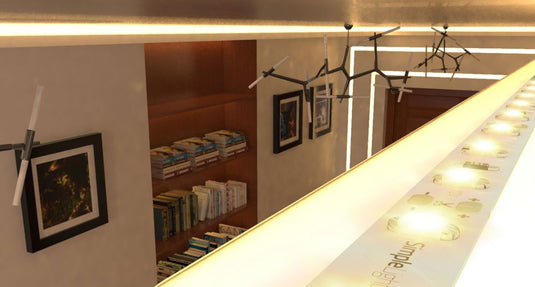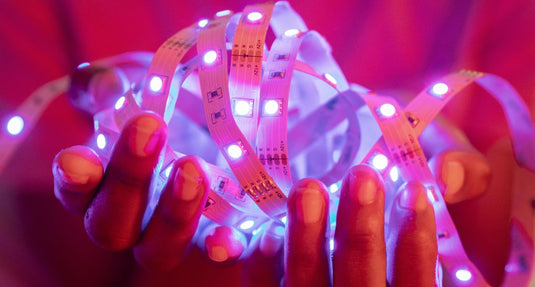For those who are conscious about our planet and try to make more eco-friendly choices in their life, then opting for normal LED lights is a must.
Compared to filament LED lights, which are similar to the well-known incandescent bulbs, normal LED lights tend to waste less energy due to the fact they produce less heat.
Normal LED light bulbs only emit light from one direction, whereas filament light bulbs will emit light from the full perimeter of the bulb, this is another key factor that makes normal LED lights more energy-efficient and better for our environment.
What Are Normal LED Light Bulbs?
Putting it simply, normal LED light bulbs are a safer alternative to buying either filament LED light bulbs or traditional incandescent light bulbs. All do the same job, but the list of pros when opting for normal LED light bulbs is much longer than if we took a look at a list of pros for filament light bulbs.
Apart from the complications when it comes to changing a normal LED light bulb (especially ceiling spotlights) and the lower measure of lumens, normal LED light bulbs are considerably safer and better for our planet, making them a better choice for your home.
What Are Filament LED Light Bulbs?
LED filament light bulbs are designed to resemble a traditional incandescent light bulb. An LED filament bulb is almost like a replica of an incandescent bulb, as they both have diodes lined up along a metal strip, unlike normal LED lights.
Phosphor is a synthetic substance that’s coated on the inside of a filament bulb, making it look identical to that of a regular incandescent bulb.
Environmental Advantages of Normal LED Lights
If saving energy and being eco-friendly aren’t already some great benefits to make you consider buying normal LED lights, then let’s run through some other ways they can be beneficial.
Zero Toxic Elements
By law, LED lights are not considered toxic and can be disposed of in regular landfills. Despite being frequently used in many households, incandescent bulbs actually have traces of mercury inside, which, at a small percentage, could potentially be released if the bulb is ever broken.
So, whether you end up buying filament LED lights or normal LED lights, at least you know they're safer to have in your home.
Improved safety
Unlike filament LED lights, normal LED lights are a lot safer to use. Safety is overlooked completely and is probably the best advantage when it comes to normal LED lights. One of the main hazards when you use filament LED lights, is the emission of heat.
Additionally, normal LED lights can operate efficiently on a low voltage electrical system. Generally, these are much safer in the event of a fire or if something else might go wrong.
Lifespan
Normal LED lights have a lifespan of 50,000 hours, unlike filament LED lights which typically only last for around 15,000 to 40,000 hours.
This is another reason why normal LED lights are great for those who are trying to become more eco-conscious.
Fewer bulbs in landfills have obvious positive effects on the environment, and choosing to use normal LED light bulbs over filament LED light bulbs means you won't have to worry about buying them as frequently, which is also great for money-saving purposes.
Why Filament LED Lights Still Remain Popular
So, with a more eco-conscious, energy-saving and cost-efficient normal LED bulb available, why do some people still choose filament LED light bulbs?
Visual Reasons
Filament LED lights are vintage-inspired bulbs that copy the visual appearance and pattern of an incandescent light bulb.
For some, this factor alone will be the ultimate decision-maker when purchasing a bulb. People could prefer buying filament bulbs purely for nostalgic novelty, or their old-school look.
Quality of Light
Looking beyond the vintage look of filament bulb lamps, they remain popular because of the better quality of light that emitted is compared to normal LED lights.
For many, it's the warm lighting of filament LED light bulbs that entices people to buy it, similar to an incandescent light bulb, it gives off light through a full 360 degrees which definitely helps them outshine their competitors.
Although we’re pushed as a society to make more eco-conscious choices where we can, many homeowners will dismiss this fact in exchange for good quality of light.
Replacing Bulbs
Although normal LED lights last longer and have a better quality of life, they can definitely prove more difficult to fix or change compared to filament light bulbs.
Unlike a traditional incandescent bulb, normal LED lights aren’t as simple to install.
This is the beauty of filament LED light bulbs, they are significantly safer than incandescent bulbs, but have the same quality of light along with an easy changing process in the case of replacement.
What Type of LED Light Bulb Should You Buy: Normal or Filament?
So, what type of LED lights should you buy - normal, or filament? Let’s have a look at a few comparisons.
Filament LED Light Bulbs
Ultimately, it's all down to preference. If you're looking for a way to make your home safer, or if you're trying to take a step in the right direction when it comes to making better choices with the environment in mind, then a normal LED light bulb will be the perfect choice for you.
As mentioned, a normal led light bulb is cost-effective and helps the planet massively.
Another added bonus is not having to go to purchase as many bulbs, as the lifespan for a normal LED can last around 20 times longer than a traditional incandescent or filament bulb.
Normal LED Light Bulbs
If you're not as bothered about the eco-friendly factors that normal LED light bulbs have to offer, and care more about having an attractive, retro look throughout your home, then filament LED light bulbs will be a better fit
Although normal LED light bulbs can be bought in a variety of different colours compared to filament LED light bulbs, it ultimately comes down to how much preferred light source you want within your home that becomes the notable decision-maker.




